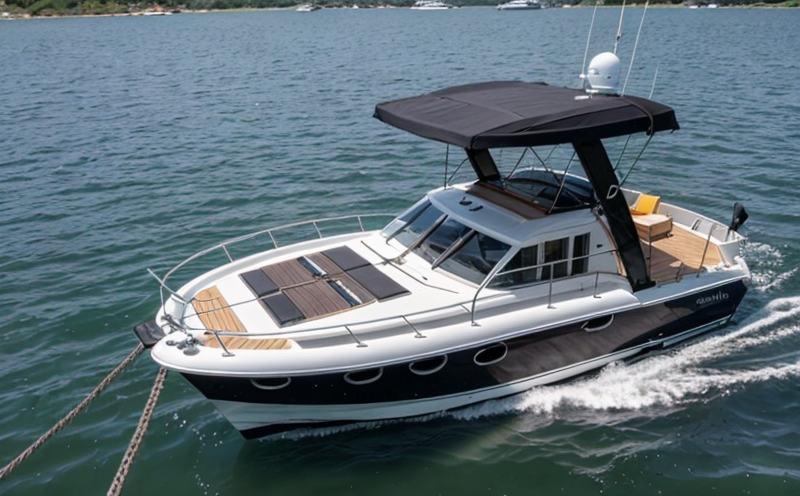ISO 6482 Fatigue Testing of Deck Crane Structures
The ISO 6482 fatigue testing standard is crucial in ensuring the durability and reliability of deck cranes used in marine environments. These structures are exposed to harsh conditions, including constant loading and unloading operations, wave action, and environmental stresses that can lead to structural fatigue. Compliance with this international standard ensures that deck crane structures meet stringent safety requirements, thereby protecting personnel and maintaining operational integrity.
The testing procedure specified by ISO 6482 involves subjecting the specimen (deck crane structure) to a series of cyclic loads designed to mimic real-world conditions. This process helps identify any potential weaknesses or areas prone to fatigue failure before they cause actual structural damage. The standard applies to various types of deck cranes, including those used in cargo handling, passenger ship operations, and other maritime applications.
Proper specimen preparation is critical for accurate results. Before testing begins, the crane structure must be cleaned thoroughly and any external contaminants removed. Specimens are then subjected to detailed inspection using non-destructive testing methods like ultrasonic examination or magnetic particle inspection to ensure integrity before fatigue loading. During the test, engineers monitor key performance indicators such as stress levels, deformation rates, and material behavior under cyclic loading.
Instrumentation plays a vital role in collecting comprehensive data during ISO 6482 fatigue tests. Load cells and strain gauges are strategically placed on critical sections of the crane to measure applied forces and deformations accurately. Advanced software systems process this raw data into meaningful insights, allowing engineers to assess the structural health of the specimen throughout its lifetime.
The ultimate goal of ISO 6482 fatigue testing is to provide robust evidence supporting compliance with industry standards while enhancing overall safety margins. By adhering strictly to prescribed protocols outlined in the standard, laboratories can ensure consistent and reliable test results across different specimens and environments. This consistency builds trust among stakeholders involved in maritime equipment design and maintenance.
In summary, ISO 6482 fatigue testing of deck crane structures is an indispensable tool for ensuring long-term reliability and safety in marine operations. It enables manufacturers to demonstrate compliance with relevant regulations while also providing valuable information about the structural integrity of their products during service life.
Why It Matters
The importance of ISO 6482 fatigue testing cannot be overstated, especially given the demanding operational conditions faced by deck cranes in marine environments. Compliance with this standard not only ensures structural integrity but also enhances overall safety and reliability.
- Increased Safety: By identifying potential weaknesses early through rigorous testing, operators can take proactive measures to prevent catastrophic failures that could endanger lives and damage property.
- Sustained Performance: Regular fatigue testing helps maintain optimal performance levels over time, extending the useful life of deck cranes without compromising on quality or safety standards.
- Regulatory Compliance: Adherence to international standards like ISO 6482 demonstrates commitment to best practices and helps meet regulatory requirements set forth by governing bodies worldwide.
In addition, implementing this testing procedure fosters innovation within the maritime industry by encouraging continuous improvement in design and manufacturing processes. As a result, manufacturers can introduce safer, more efficient products that better serve the needs of global shipping networks.
Scope and Methodology
The scope of ISO 6482 fatigue testing encompasses all aspects related to the structural evaluation of deck crane systems. This includes but is not limited to:
- Cyclic loading simulations mimicking actual operational conditions in marine environments.
- Inspection methods such as ultrasonic examination, magnetic particle inspection, and visual inspections before starting tests.
- Data collection using load cells and strain gauges placed on critical sections of the crane structure.
The methodology follows precise guidelines stipulated by ISO 6482. Specimens are subjected to cyclic loading until they reach a predetermined number of cycles or exhibit signs of fatigue failure. Throughout this process, engineers closely monitor key parameters like stress levels and deformation rates to determine whether the specimen meets specified criteria.
Once testing is complete, detailed reports are generated summarizing all collected data points. These reports serve as comprehensive documentation supporting compliance with ISO 6482 requirements while providing valuable insights into the structural behavior of deck crane systems under various loading scenarios.
Environmental and Sustainability Contributions
The implementation of ISO 6482 fatigue testing contributes significantly to environmental sustainability efforts in several ways:
- Prolonged Operational Lifespan: By ensuring deck cranes remain structurally sound over extended periods, this testing minimizes the frequency of replacements and subsequent waste generation associated with premature failures.
- Energy Efficiency: Safer and more reliable operations lead to optimized energy consumption patterns, reducing carbon footprints in maritime activities.
- Material Optimization: Insights gained from these tests enable manufacturers to optimize material usage, leading to reductions in resource depletion rates.
Furthermore, adherence to ISO 6482 helps promote responsible stewardship of natural resources by fostering a culture of continuous improvement within the maritime sector. This approach aligns with broader global initiatives aimed at promoting sustainable development across industries.





